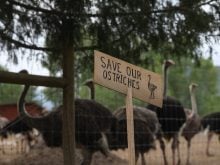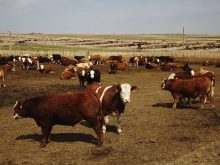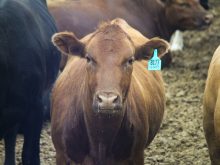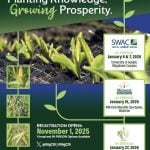RED DEER – Another year of drought could have a major impact on the
North American beef herd at a time when prices are up and demand is
growing.
“One of the biggest issues for the industry is what kind of conditions
we have this year,” said Anne Dunford, senior market analyst for
Canfax.
She and Mike Murphy, of the American analysis firm Cattlefax explained
the state of the North American industry at the annual Alberta Cattle
Read Also

Lending policy still focused on primary producers: Farm Credit Canada
Farm Credit Canada said it has not changed its business practices and remains committed to supporting all producers, after a report from an Ottawa-based media outlet claimed otherwise.
Feeders Association meeting in Red Deer.
They delivered a message of concern over continuing dry weather mixed
with optimism about increasing consumer demand.
“The economics are there for expansion but drought will play a key
role,” said Murphy.
With the largest cow herd in North America at five million cows, Texas
tips the balance in favour of expansion.
“If they can get into a situation where they get sustained moisture,
they alone can change the outlook in terms of where the herd is going
in the next couple years,” said Murphy.
The cattle cycle is at a low point with 33.1 million cows in the United
States, down almost one percent from last year. The Canadian cow herd
Jan. 1 was 4.27 million, up about one percent.
The Canadian herd is poised for expansion but serious drought on the
western Prairies saw about 800,000 cows sold last fall. The annual cull
rate is about 11 percent of the herd while last year it reached 15
percent.
“That was not a big surprise. We’re not expecting growth in the
conditions we have had,” said Dunford.
In addition, heifers in Canada and the United States continue to be
sold for beef resulting in an older cow herd.
Despite lower numbers, the North American herd has gained productivity
by adding an average six pounds per year to carcass weights since 1970.
Murphy anticipates continued improvements in weight gain over the long
term due to better genetics, management and feeding regimes.
In 2001, Canadian steers and heifers averaged about 20 pounds heavier
from a year ago.
Increased weight gains and continuing high numbers of animals going on
feed produced record high levels of beef production.
Canada produced a record 3.4 billion lb. in 2001.
In the U.S., 26.1 billion lb. were produced.
This heavy supply in both countries forced some packers to run shorter
work weeks until the supply was consumed.
While there is plenty of beef available, it continues to command higher
prices at the retail level.
Consumer beef expenditures are increasing year by year in Canada and
the U.S. If demand had remained flat with the high amount of beef
available, prices would have been much weaker for live cattle.
Grain prices are another aspect affecting this year’s live cattle
prices.
U.S. corn ending stocks are dropping and corn demand is flat. Both
analysts anticipate volatile corn prices this summer but hope a good
harvest will return stability to the market.
If grain is higher and break-even prices increase, feedlots are
reluctant to bid up calves. Alberta feedlots experienced record high
break-even prices and input costs during the last half of 2001 partly
because of expensive feed.
Other shifts are also occurring in the live cattle trade for the
Prairies and northwestern states.
Last year, Canada imported 220,000 feeder cattle. But because of
drought and high barley costs, imports were down about 70 percent in
January. Feeders are now leaving Canada at a fast pace – about 65,000
to Feb. 9, up 77 percent from last year.
These exports are continuing to drive the Canadian cattle economy.
Final export figures for 2001 show 57 percent of all Canadian
production was shipped out of the country as live animals, or as boxed
beef. The lion’s share went to the U.S. although Mexico has grown into
the second largest buyer of Canadian beef.
Both countries are experiencing continuing consolidation among packers
and retailers. In the U.S., the top four retailers sell 65 percent of
the beef and the top four packers process 78 percent of the beef. On
the feeding side, 32 of the largest cattle feeding operations finish 57
percent of the total supply.
In Canada, Alberta has become the largest feeding and processing
region. Last year, 72 percent of all finished beef came out of Alberta.
Canadian packers are changing the way they do business.
In 1998, 68 percent of cattle were sold on a cash basis. In 2001, that
figure dropped to 60 percent with more cattle being involved in
formula-based marketing, contracts or were packer owned.
Formula marketing accounted for 16 percent of sales compared to 10
percent three years ago. Packer ownership of cattle has also
strengthened where they own 19 percent of their supply compared to 14
percent in 1998.
During the last year more packers began running their businesses
differently and if they continue to earn profits, they may attempt to
control supply even further.
North America is also seeing concentration of the supermarket sector.
Some analysts predict that within five years the top five to seven
retailers may control nearly 75 percent of food sales, which could lead
to more grocer power over the food industry, forcing further
consolidation, single source suppliers and just-in-time deliveries.















